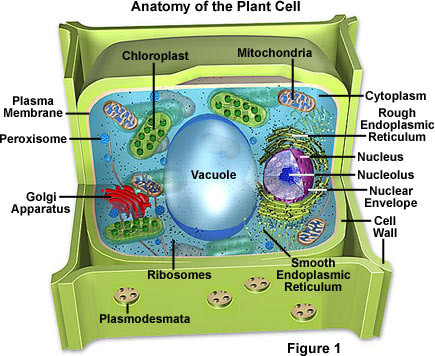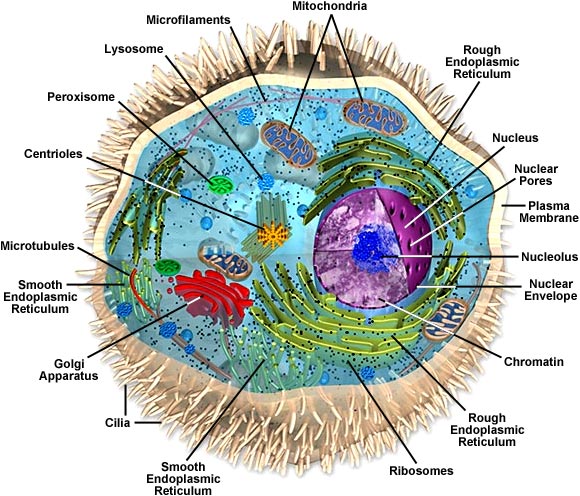Biology Forum › Cell Biology › PLANT AND ANIMAL CELLS
- AuthorPosts
- December 1, 2005 at 4:34 am #2723
 tiredParticipant
tiredParticipanthelp i need to know the difference between plant and animal cells
Plant Cells and ANIMAL CELLS
- December 1, 2005 at 5:10 am #34004
 BiologyIs4LifeParticipant
BiologyIs4LifeParticipantHere you go! 😀
Hope this helps…PLANT CELLS: http://www.plantcell.org/
ANIMAL CELLS: http://www.purchon.com/biology/cells.htm
To sum it up:
plant cells have a cell wall and animal cells don’t! - December 1, 2005 at 5:36 am #34007
 SabbyParticipant
SabbyParticipantAnimal cells and plant cells are very similar, but…
Plant Cells:
Cell Wall around cell membrane, large Central Vacuole(holds water for structural support; also called Turgor)
Plastids called Chloroplasts which perform photosynthesis - December 1, 2005 at 1:49 pm #34028
 cool A-level studentParticipant
cool A-level studentParticipantplant cells are also more structured than animal cells, they form a certain hard shape (which holds the plant up i guess) whilst animal cells sort of form a blob, something to do with the cell wall as that increases the outermost structure of the cell.
there are added organnelles like the vauole (storage area) which is only in plant cells, also plant cells have cell walls, animal cells don’t ect…
hope it helps 😉
- December 1, 2005 at 2:16 pm #34031
 new_guyParticipant
new_guyParticipant……I read somewhere which says that small vacuol do appear at certain animal cells..(maybe I’m wrong….I have poor memory…)
And I’m pretty sure that plant cells able to make carbohydrates which provide energy….animal cells can not make carbohydrates themselves… - December 1, 2005 at 3:12 pm #34032
 Starlight189Participant
Starlight189ParticipantWell at GCSE level I was told animal cells don’t have a vacuole…now at AS level I’ve been told they do…confusing!
- December 1, 2005 at 7:26 pm #34042
 PoisonParticipant
PoisonParticipantGenerally, animal cells can have small vacuoles or none. The vacuoles get larger in pathologic cases.
- December 2, 2005 at 2:11 am #34067
 animejunkie13Participant
animejunkie13ParticipantANIMAL:
1: no cell wall
2: can make skin, hair, ect,
3: can/cannot have a vacoule
4: ( plants dont have mitochondria, do they?)
PLANT:
1: outer cell wall
2: chloroplasts whcih make them green and are used in photosynthesis
3: DO have a vacuole.and…..(something else….really bad memory..)
- December 2, 2005 at 3:52 am #34074
 canalonParticipantquote animejunkie13:ANIMAL:
canalonParticipantquote animejunkie13:ANIMAL:
1: no cell wall
2: can make skin, hair, ect,
3: can/cannot have a vacoule
4: ( plants dont have mitochondria, do they?)
PLANT:
1: outer cell wall
2: chloroplasts whcih make them green and are used in photosynthesis
3: DO have a vacuole.and…..(something else….really bad memory..)
Animal, 4/ Yes they do. Besides photosynthesis, they also respire, and have mitochondria.
- December 2, 2005 at 11:35 am #34088
 victorParticipant
victorParticipantBut usually plants’ mitochondria are smaller in amounts that animals’ mitochondria..
- December 2, 2005 at 2:07 pm #34107
 cool A-level studentParticipant
cool A-level studentParticipantanimal cells can have vacuoles for storage but generally not and the 1’s that do are small
- December 3, 2005 at 1:05 pm #34177
 th1_rhs13Participant
th1_rhs13ParticipantIs that so? My book regards lysosomes as being the counter part of Vacuoles in Animal cells.
Also they serve as a an Enzyme storage as well as digestion–hence the correlation to lysosomes.
- December 3, 2005 at 2:20 pm #34187
 victorParticipant
victorParticipant??I think that vacuoles are used as a starch storage and the rest of metabolism…but not enzymes….am I wrong?
- December 3, 2005 at 2:34 pm #34193
 MrMisteryParticipant
MrMisteryParticipantSorry to dissapoint you victor but he is right. Vacules are the counterparts, so to speak, of lysosoms in the animal cell, reason for some scholars to name them fitolysosomes. Here are the roles of vaculoes in plants(the ones i can remember):
-in cellular digestion(same as animal lysosomes)
-in depositing: sucrose(enters the vacuole by a H+ assisted antiporter), Na,Ca(that also enter the vacuole by a proton antiporter), Cl, nitrates(enter the cell through channels)
– in regulating cellular volume(as we know, in plants the vacuole is 70-80% of the cell volume)
-in polenisation(they accumulate antocyan pigments)
The vacuole has an extremely well developed H+ pump, that can give the vacuole a pH of even 2! This is a mechanism that is characteristic to plant cells:
UTP –> UMP +Pi~Pi
It is one of the only cases where uridine triphosphate is used as an energy source in the living world. The vacuole’s H+ pump works on pirophosphateNow, the plant cell doesn’t store starch in vacuoles, it stores it in a special kind of plastid called amiloplast.
Check the alberts book on the subject for more info, that is where i learned all this stuff..
- January 2, 2006 at 8:45 am #36007
 animejunkie13Participantquote th1_rhs13:Is that so? My book regards lysosomes as being the counter part of Vacuoles in Animal cells.
animejunkie13Participantquote th1_rhs13:Is that so? My book regards lysosomes as being the counter part of Vacuoles in Animal cells.Also they serve as a an Enzyme storage as well as digestion–hence the correlation to lysosomes.
yeah, but lysosomes are in plant cells too, so, why would they be there?
- January 2, 2006 at 9:30 pm #36028
 PoisonParticipant
PoisonParticipantThere are no lysosomes in plant cells. There are just some particles to do some work.
- January 4, 2006 at 6:29 pm #36175
 EnzymeParticipant
EnzymeParticipant - January 4, 2006 at 9:55 pm #36206
 MrMisteryParticipant
MrMisteryParticipantnice pictures. where did you get them from?
- January 5, 2006 at 12:01 pm #36248
 EnzymeParticipant
EnzymeParticipantHere you have the URLs :wink::
– Animal cell:
http://micro.magnet.fsu.edu/cells/anima … alcell.jpg– Plant cell:
http://micro.magnet.fsu.edu/cells/plant … ntcell.jpg - January 6, 2006 at 6:44 pm #36346
 CoolJay221Participant
CoolJay221Participantplant cells have chloroplasts and animal cells don’t. animal cells have centroils and plants don’t. plant cells ahve a cell wal and animal cells don’t.
- AuthorPosts
You must be logged in to reply to this topic.

